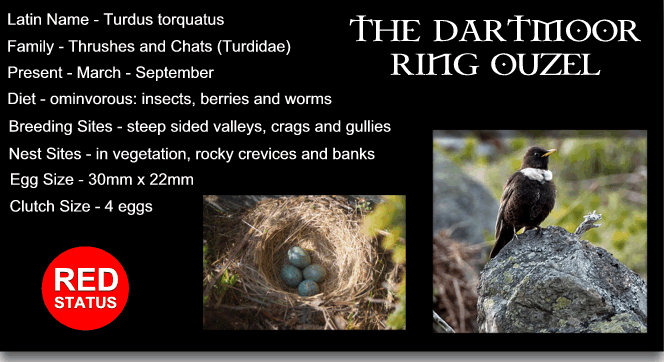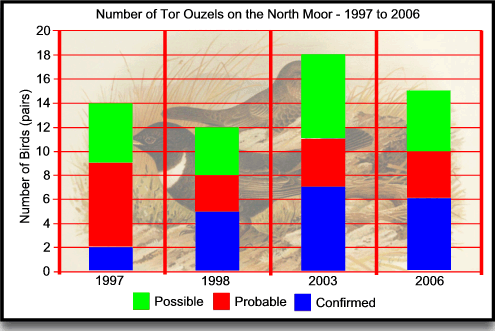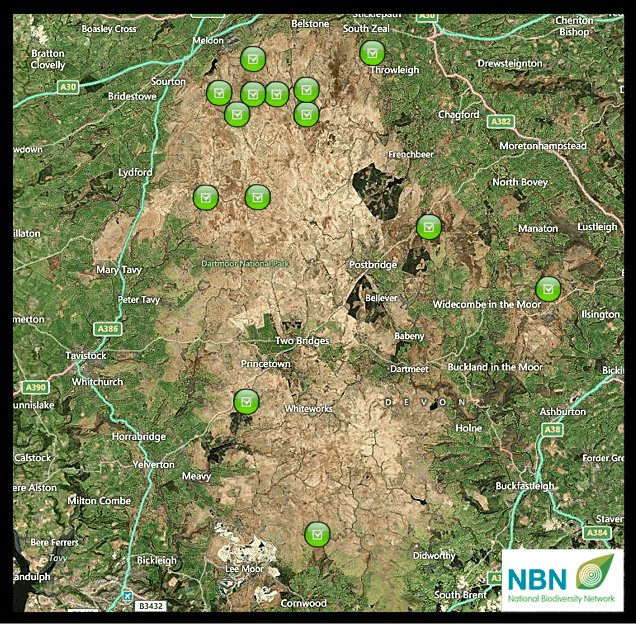
|
Ode to a Pair of Ring-Ouzels A deep and solemn silence broods Over the breezy solitudes Whereon the mountaineer intrudes To crown a summer climb: The soaring lark, a dreamy bee, A pipit twittering from the lea Beguiled the journey, but no glee Disturbs the peak sublime. |
Yet music haunts it, and ere long From some wild crag will float a song, Perchance the protest loud and strong Of one who brooks no guest; Perhaps a love-plaint true and clear, Meant to attract the distant ear Of wandering mate called back to cheer, Or mind the busy nest.
|
Sweep the grey boulders, and you soon Shall see the form from whence flows the tune, And mark a crescent like the moon, Beneath a sable throat, With golden lips that warble till The yearnings melt into a trill Of joy, as flitting round the hill The truant hears his note. Marcus S. C. Rickards, M.A. F.L.S. |
The ‘Rock Ouzel‘, ‘Tor Ouzel‘ or ‘Moor Blackbird‘ are all old Devonshire names for the Ring Ouzel, a charming bird that was once fairly common on Dartmoor. The bird’s name goes back to the old Anglo Saxon word ösle which translates as ‘blackbird’, Clark Hall, p. 270, and then there is ring which pertains to it’s distinctive white chest bib thus giving Ring Ouzel. As this is a webpage pertaining to Dartmoor I will use the name of Tor Ouzel form here on in, plus the fact that it sounds much better.
As can be seen from the two extracts below the bird was a frequent visitor to the uplands of Dartmoor during the late 1800s:
“Ring Ouzels arrive at the end of March and during the first days of April, on Dartmoor; nesting in rocks on the top of the Tors, in the steep banks of streams, and in old quarries. It feeds on Whortleberries. In September the Ring Ouzels resort to the valleys bordering on the moor, where they subsist partially on Blackberries They leave in October, when stragglers may be met with on the tops of the sea cliffs; this species occasionally prolongs its stay with us into the middle of winter They appear to confine themselves principally to high and lonely Tors, and there, as you wander amongst the huge detached blocks of granite, they may be observed hopping from stone to stone… Ring Ouzels uttering their somewhat wild and plaintive call notes in every direction, more especially in the neighbourhood of ‘Tavy Cleave,’ at which place, when botanising with some friends among the rocks, heath and furze a few years ago, we found several nests and eggs; and I feel perfectly satisfied that this species may be found annually breeding in suitable localities over the whole extent of the moor. It has a habit of hiding under rocks and large stones when pursued, and if found will suddenly start away with rapid flight to a long distance, emitting its chucking alarm-notes all the way. It has also the habit, especially when its nest is approached, of alighting on a rock or stone near or hopping along the ground with drooping wings and elevated tail, at the same time uttering the quickly repeated ‘ chuck, chuck, chuck,’ of alarm.”, Pidsley, 1891. pp 3- 4.
“A summer migrant, frequenting many of the rocky Tors of Dartmoor, e.g. Yes Tor, Vixen Tor, Greater and Lesser Lynx Tor, especially when the whortleberries are ripe in July and August. Also Trowlesworthy Rabbit Warren, Shaugh Moor, and Pyles on Harford Moor. It is, however, found on every portion of the moor, and is almost the only denizen of its dismal central swamps. It is very sensitive to cold winds, and is always found on the lee-side of a Tor…. On Dartmoor “the nest is frequently found in the side of a turf-tie, that is, a pit from which they dig turf for fuel.”, D’Urban, 1891. p.7.
Eden Phillpotts in his own unique way put his thoughts on the Tor Ouzel to pen and paper as an be seen below:
“The migrant ring-ousel builds year after year in a granite quarry, and I have often heard him there. It is a solitary, forgotten place and he knows it better than most living people. He sang last spring from a rusty rib of old iron, driven into the rock by men long dust. His song differs from the intimate music of his kinsfolk, the blackbird and thrush. It is thinner, colder, more elfin—the pure tinkle of a mountain brook. With some birds you feel that they like you to listen to them ; not so the shy ring-ousel. One pays something in time and patience for his song, and values it the more.” Phillpotts, 1919. p.38.
To hear the song of the Tor Ouzel click the RSPB link opposite where you will also find further facts about the bird.

Sadly it is a very different story in 2012 as nationally the Tor Ouzel has been given the dreaded red status which means that it is officially classified as being: “globally threatened with a historical population decline in the UK during 1880 – 1995 with at least a 50% decline in the UK breeding population over the past 25 years“. In 2007 the Dartmoor National Park Authority initiated their latest ‘Dartmoor Biodiversity Action Plan’. In this the ‘Action Plan’ for the Tor Ouzel stated that; “The population of Tor Ouzels on Dartmoor appears to have declined by around 30% since 1979. In 2006 the MoD survey of the north moor, plus other supplementary records, lead to a population estimate of 10 – 15 pairs for Dartmoor.”, Action for Wildlife, 2007. p.178. The main reasons given for this decline were; climate change, gorse and bracken growth, agricultural practices, and disturbance during the breeding season by recreational users of the moor and military activities.

When considering climate change it was suggested that some of the upland areas where the Tor Ouzels used for breeding sites are slowly becoming lowland areas in character which is not conducive for the bird. The next threat came from the increase in bracken and gorse growth which eventually reduces the available foraging sites near any prospective nesting sites. This scenario is indicative of the reduction in grazing livestock numbers upon the moor because less animals eating and trampling the plants means ideal growing conditions for both species – nature abhors a vacuum. Taking the previous point into consideration it was also suggested that burning or swaling of bracken and gorse would have a detrimental effect if carried out in proximity of breeding sites. This effect would obviously be greater in the breeding season, this then gives the perfect catch 22 situation, the gorse and bracken need to be controlled but it can’t be done by burning because that would cause other issues? Human disturbance was also another huge factor at breeding sites, especially in the breeding season. The finger for this has been pointed at two main parties, recreational users and military personnel. In the first case the impact was deemed greater when, “large scale events” take place, which I presume includes the annual Ten Tors event? Letterboxers have also been a cause for concern due to the, “constant disturbance” they create by the very nature of the activity. Military activities were also be blamed for disturbance in the various ranges for obvious reasons.

Having identified the issues what solutions did the 2007 Action Plan come up with? Having commissioned surveys in 1997 and 1998 the numbers of pairs, the key sites were identified along with the measurement of disturbance. In 2006 another survey was commissioned by the MoD on the north moor which had been indentified as a Tor Ouzel ‘hotspot’. Following the MoD survey they began assessing the data regarding the breeding sites and then considered what action could be taken to reduce the disturbance at various locations which included Steeperton Tor, Fur Tor and Tavy Cleeve. A further management plan was put in place that involved the MoD and Natural England on the Willsworthy range, this would encompass Tavy Cleeve.
The problem of disturbance by recreational users was addressed by implementing a voluntary exclusion of the breeding sites by letterboxers, campers and guided walks during the breeding season. These areas were identified on a freely available map and as far as letterboxers went this advice was generally heeded.
The annual burning of vegetation on the commons was controlled by annual fire plans which were/are drawn up by the Dartmoor Commoner’s Council along with individual Commoner’s Associations and the Moorland Fire Group. Mysteriously, grazing numbers were reduced throughout the West Okement area by means of agri-environment agreements. It was hoped that this measure would promote heathland habitats?
All of the above measures were put in place to achieve two objectives, firstly to; “Ensure that Dartmoor remains a significant breeding area for Ring Ouzels.”. Secondly, to; “Provide a greater understanding and awareness of Ring Ouzels on Dartmoor.”, DNPA, p.180. Various actions to achieve the above goals were set in place along with targets and completion dates all of which were to be monitored by the RSPB. Numerous groups and societies became involved and the list comprised of: the Dartmoor National Park Authority, the Ministry of Defence, the Duchy of Cornwall, the RSPB, Natural England, the Dartmoor Commoner’s Council and the Devon Bird Watching and Protection Society.

Click buttons for past Dartmoor Tor Ouzel Sightings – (for further details follow the BNB link opposite)
In 2010 a ‘Dartmoor Ring Ouzel Productivity Study was carried out by the RSPB and funded by Natural England. It was carried out between the 1st of May and the 4th of August and the survey areas were located in north west Dartmoor within the Okehampton MoD area. The actual operation involved regular forays in search of the birds and once nesting sites had been found regular visits to monitor the various situations. The results of this survey were grim to say the least, all in all fourteen nesting sites were located (some were second and third attempts at breeding) and involved eight pairs of Ouzels. Of the fourteen nests ten failed and the remaining four produced a total of twelve fledgelings. The largest cause of the nest failures was predation by the likes of badgers, stoats, crows and in one case an otter. It was observed that the nest locations were diverse and included steep-sided river valleys that had areas of broken ground containing boulders, bracken, gorse and whortleberries. The bird’s feeding areas comprised of short grassland and were generally located within 500m of the nest site. One could argue that apart from the numbers of birds the information gleaned is not a lot different from what was know in the late 1890s (see above)?
In 2011 another survey was undertaken, once again carried out by the RSPB and funded by a £30,000 grant from the SITA Trust (see link opposite) with assistance and additional funding coming from; the Dartmoor National Park Authority, Natural England, the Ministry of Defence, the Duchy of Cornwall, the Dartmoor Study Group and the British Trust for Ornithology. The methodology of this survey was very much the same as the previous one and was conducted by two full time surveyors with some extra help when needed. Additional information was also collected which included types of prey taken by the Tor Ouzels, signs of predators around the nesting sites, the human interference factor and the effect other bird species made with regards to food competition. Infra-red cameras and motion detectors were used in some locations to allow for more detailed findings.
The result of this work revealed that during 2011 there was a total of between ten and twelve pairs of Tor Ouzels which was a slight improvement on 2010s eight. A total of twenty one nest sites were found but only nineteen provided detailed histories, again an improvement on 2010s fourteen. Of the nineteen nest sites it was found that ten were unsuccessful and the remaining nine produced thirty nine fledglings which was a large increase on the previous year, (thirty nine compared with twelve). Once again predation was a major issue which accounted for a 48% loss and was attributable to mammalian and avian predators. One of the cameras actually recorded a fox raiding a nest site with a clutch of eggs and a sitting female. It was also reported that human disturbance many have also contributed to the predation loss by scaring away the sitting female thus leaving the eggs exposed to would-be predators. There were several variants in both surveys such as an increase in monitoring in 2011, two annual surveys in 2011 compared with one in 2010. Additionally there was one new site recorded in 2011 (Lakedown) and it was admitted that very little monitoring had been carried out in Tavy Cleeve during 2010. All these factors slightly hinder the year on year comparisons especially when the more favourable weather conditions in 2011 are taken into account.
Once again the nest sites were similar in each year as were the feeding grounds, however there was an increase in the distance of the foraging journeys which extended to 600 – 700m.
The main recommendations following the 2011 survey were to minimise human disturbance whenever and wherever possible by promoting the the Rare Bird Sensitive Areas maps. To create more favourable vegetation in feeding areas, create no-burn areas near breeding sites also to assess the whortleberry stands from which the birds feed on. It is also interesting to note that since the 2007 statement that; “gorse and bracken growth may be reducing foraging areas near nest sites,” Action for Wildlife, p. 178., that there is now the thinking that the gorse is being used for nesting and protection for the fledglings and should be encouraged? It strikes me that one of the biggest problem for the Tor Ouzels are the natural predators which occur on Dartmoor which appear to have a penchant for the birds. I think if steps were taken to control these animals another debate would soon follow, after all who would want to see badgers or otters killed? One could also argue that the banning of fox hunting has resulted in an increase in population numbers which has in turn led to them predating the Tor Ouzel? There is very little anyone can do about the effects of so-called climate change and its effect on vegetation. It is interesting to note how the whortleberry is an important food source for the Tor Ouzel and that during the late 1800s this too was a important food and cash crop for the Dartmoor dwellers. This being the case both would have been in competition for the whortleberry yet the Ouzel population was much higher then?
There is however something that can be done regarding human disturbance and as noted in the report that is through education and awareness. I must admit that when the exclusion zones were introduced during the nesting season I never really paid them much attention. However, if the true extent of the Tor Ouzel’s decline had been made clear I would have certainly heeded the request to stay away from the breeding areas, maybe this could still be the case for others today?There is a ground nesting bird factsheet available from the DNPA in pdf format which can be downloaded – HERE.
The Tor Ouzel makes a probable appearance in the legend of the ‘White Bird of Oxenham‘ which is said to appear just prior to a death occurring in that family.

J. R. Clark Hall. 2004. A Concise Anglo-Saxon Dictionary. Canada: University of Toronto Press.
Dartmoor National Park Authority. 2007. Action for Wildlife – The Dartmoor Biodiversity Action Plan.
W. S. M. D’Urban & Rev. M. A. Mathew. 1891. The Birds of Devon. London: R. H. Porter
Phillpotts, E. 1919. A Shadow Passes. New York: McMillan Company
W. E. H. Pidsley. 1891. The Birds of Devonshire. Exeter: J. G. Commin
 Legendary Dartmoor The many aspects past and present of Dartmoor
Legendary Dartmoor The many aspects past and present of Dartmoor
